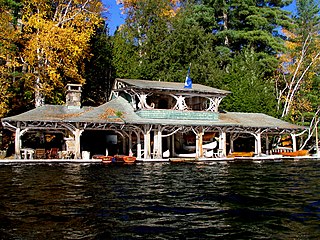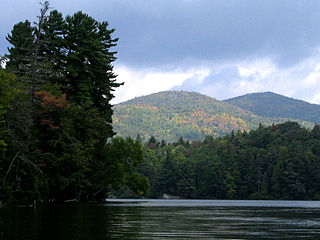
Franklin County is a county in the northern part of the U.S. state of New York. It borders the Canadian provinces of Quebec and Ontario. As of the 2010 census, the county population was 51,599. Its county seat is Malone. The county is named in honor of United States Founding Father Benjamin Franklin.

Brighton is a town in Franklin County, New York, United States. The population was 1,435 at the 2010 census. It was named after Brighton, England, by early surveyors in the region.

The Adirondack Park is a part of New York's Forest Preserve in northeastern New York, United States. The park's boundary corresponds with the Adirondack Mountains. Established in 1885, it was the first state preserve of its type in the nation. Unlike most preserves, about 52 percent of the land is privately owned inholdings heavily regulated by the Adirondack Park Agency. This area contains 102 towns and villages, as well as numerous farms, businesses, and an active timber harvesting industry. The year-round population is 132,000, with 200,000 seasonal residents. The inclusion of human communities makes the park one of the great experiments in conservation in the industrialized world. It was designated a National Historic Landmark in 1963.

The Saint Regis Canoe Area in Adirondack Park is the largest wilderness canoe area in the Northeastern United States and the only designated canoe area in New York state. It is closed to motorized vehicles. Among the 58 ponds and lakes are Upper Saint Regis Lake, part of the Seven Carries route, and Saint Regis Pond. It contains the headwaters of the West and Middle Branch of the Saint Regis and the Saranac Rivers. Only two of the lakes can be reached without a portage, or carry as it's known in the region. Primitive canoe camping is permitted on many of the lakes and ponds. Saint Regis Mountain and Long Pond Mountain are within the area.

Paul Smiths is a hamlet and census-designated place (CDP) in the Town of Brighton in Franklin County, New York, United States. It is located on Lower Saint Regis Lake in the Adirondacks, 12 miles (19 km) northwest of Saranac Lake, located at 44°26' North 74°15' West. The population of the CDP was 671 at the 2010 census.

The Great Camps of the Adirondack Mountains refers to the grandiose family compounds of cabins that were built in the latter half of the nineteenth century on lakes in the Adirondacks such as Spitfire Lake and Rainbow Lake. The camps were summer homes for the wealthy, where they could relax, host or attend parties, and enjoy the wilderness. In time, however, this was accomplished without leaving the comforts of civilization behind; some great camps even contained a bowling alley or movie theatre.
Lake Clear is a hamlet and a lake in Franklin County, New York, United States. The area is named for 940-acre (3.8 km2) Lake Clear, part of the original Seven Carries canoe route. It is located in the town of Harrietstown.

Camp Topridge is an Adirondack Great Camp bought in 1920 and substantially expanded and renovated in 1923 by Marjorie Merriweather Post, founder of General Foods and the daughter of C. W. Post. The "camp", near Keese Mill, in the U.S. state of New York, was considered by Post to be a "rustic retreat"; it consisted of 68 buildings, including a fully staffed main lodge and private guest cabins, each staffed with its own butler. It was one of the largest of the Adirondack great camps and possibly the most elaborately furnished.

Benjamin A. Muncil was an American master builder in the Adirondacks early in the 20th century. He was a major figure in the architectural development of the Adirondack Great Camps; among his many projects was Marjorie Merriweather Post's Camp Topridge, Northbrook Lodge, and White Pine Camp, a summer White House of US President Calvin Coolidge.

350-acre (1.4 km2) Lower St. Regis Lake is a part of the St. Regis River in the Adirondacks in northern New York State. At its northern edge is Paul Smith's College, former site of Paul Smith's Hotel. Along with Upper St. Regis Lake and Spitfire Lake, it became famous in the late 19th century as a summer playground of America's power elite, drawn to the area by its scenic beauty and by the rustic charms of Paul Smith's Hotel. It is the site of a small chapel, originally built of logs, St. John's in the Wilderness, that was formerly attended by well-dressed families that arrived in canoes, rowboats and sailboats.

250-acre (1.0 km2) Spitfire Lake is a part of the St. Regis River in the Adirondacks in northern New York State. Along with Upper and Lower St. Regis Lake, it became famous in the late 19th century as a summer playground of America's power elite, drawn to the area by its scenic beauty and by the rustic charms of Paul Smith's Hotel. It is the site of many grand old summer "cottages" and Great Camps; Frederick W. Vanderbilt, Anson Phelps Stokes and Whitelaw Reid were among the summer residents. "The camps of many of these families began as tent colonies, with separate units for sleeping, dining, games, and so on, and evolved into permanent structures built with understated taste."

Begun in 1882, Camp Wild Air was the first permanent camp on Upper Saint Regis Lake, in the town of Brighton, Franklin County in New York's Adirondacks. The camp was built by New York Herald Tribune publisher Whitelaw Reid on a 29-acre (12 ha) peninsula accessible only by water. It presently consists of 12 buildings, 10 of which were built before 1931.

The Seven Carries is an historic canoe route from Paul Smith's Hotel to the Saranac Inn through what is now known as the Saint Regis Canoe Area in southern Franklin County, New York in the Adirondack Park. The route was famous with sportsmen and tourists from major east-coast cities from the late 19th century through the 1930s; interest has revived in recent years. Despite the name, the route consists of only six carries, or portages.

Keeses Mills, a.k.a. Keeses Mill and rarely Keese Mill, is a hamlet west of Paul Smiths, New York in the Town of Brighton, Franklin County, New York in the Adirondacks. It is named for a sawmill that was located on the Keeses Mills dam on the Saint Regis River. Keeses Mills road, which starts at Paul Smiths, is the only road in the hamlet; it provides access to Black Pond and Long Pond, trails to Saint Regis and Jenkins Mountains and the Saint Regis Esker Trail, and the middle branch of the Saint Regis River.

St. John's in the Wilderness Episcopal Church is an Episcopal church in Paul Smiths in the Adirondacks, New York State, United States. It was founded in 1876 by Dr. Edward Livingston Trudeau with the help of Paul Smith and many of the wealthy camp owners around Spitfire, Upper, and Lower Saint Regis Lakes. The original log building burned in 1928, and was replaced by the present structure, designed by William G. Distin, in 1930. The non-denominational cemetery surrounding the church contains the graves of Dr. Trudeau, Paul Smith, Charles Minot Dole, Clifford R. Pettis and several other notable residents of the area.

Apollos (Paul) Smith (1825–1912) was an American hunting and fishing guide from Vermont who founded the Saint Regis House in the Town of Brighton, New York, in the Adirondack Mountains. It was known universally as Paul Smith's Hotel, one of the first wilderness resorts in the Adirondacks. In its day, it was the most fashionable of the many great Adirondack hotels, patronized by American presidents, celebrities, and the power elite of the latter half of the 19th century. It was a large operation, with 255 rooms, stables, and many other amenities.

Saint Regis Mountain is a 2,874-foot (876 m) mountain in the town of Santa Clara, New York, in Franklin County at the center of the Saint Regis Canoe Area in the Adirondack Park.
















